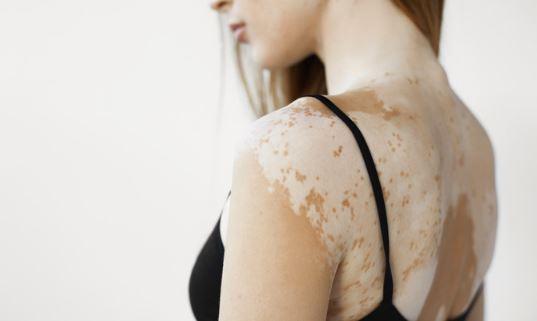
Vitiligo (Safed Daag) - Possible Causes, Treatments, and Support.
Share
What is Vitiligo (Safed Daag)?
Vitiligo ( Safed daag ) is a condition that makes your skin lose its colour or pigment, also known as melanin. This makes your skin look lighter than it I,s or turns white. When spots on your skin lose colour, they are called macules if they are less than 1 centimetre wide and patches if they are more than 1 centimetre. If you have vitiligo on the part of your body where you have hair, your hair may also turn white or silver.
The condition happens when your own immune system in your body targets and destroys the melanocytes. Melanocytes are the cells in the skin that produce melanin, the pigment that imparts the skin its colour.
What causes vitiligo (Safed Daag)?
Vitiligo ( Safed Daag ) is caused by a lack of pigment (melanin) in the skin. No one knows why these things happen. Research shows that vitiligo might be caused by:
- Autoimmune condition: Your immune system thinks that healthy cells (called melanocytes) are harmful invaders, like bacteria, and attacks them. This is known as autoimmunity, when your immune system overreacts and makes antibodies that attack and kill your melanocytes.
- Changes in your genes: A mutation or a change in your body's DNA can change how your melanocytes work. More than 30 genes can make you more likely to get vitiligo.
- Stress: The amount of pigment your melanocyte cells make can change if you are under a lot of physical or emotional stress, especially after an injury.
- Environmental triggers: Things like exposure to environmental pollutants can change how your melanocyte cells work.
- Cellular Oxidative stress: An imbalance of redox status within the cells and an imbalance or depletion of antioxidants such as catalase, glutathione, superoxide dismutase, etc.
How Is Vitiligo (Safed Daag) Treated?
There's no way to "cure" vitiligo. Some spots will get better on their own. Treatments can help those who don't get an even skin tone. Some vitiligo treatments can be done at home, while other treatments need to be done by a dermatologist. Just keep in mind that everyone's results will be different. Because of multiple and uncertain causes, the treatment of vitiligo is unpredictable. It may work for one person but might not work for another, and no treatment will likely make the spots go away 100% of the time.
If you have vitiligo, here are some tips to help:
- Sunscreen. One of the most essential things to do to prevent skin cancer is to wear sunscreen daily. And because vitiligo spots don't have melanin, they can't get tan, so they can burn and leave scars. If you have light skin, tanning because of the sun on the rest of the body will only make the white spots stand out more.
- Cosmetics. There are different kinds of concealers that you can buy over the counter. Ask your doctor for suggestions and try out different but good-quality brands.
-
Medical Treatment. Corticosteroids are a medicine that can help "pigment" the skin if put on white patches very early in the disease. They eliminate the inflammation that makes the skin lose pigment so that its pigmented cells can grow back. It is used orally as well as topical creams. Another therapy is using topical calcineurin inhibitors.
- PUVA: It stands for photochemotherapy with ultraviolet A. Two steps make up PUVA: First, a medicine called psoralen is put on the white patches of skin or taken by mouth. After this, ultraviolet light is thrown on the skin from an artificial source like a UVA lamp. Sunlight exposure is also recommended. This makes the affected skin turn pink, but over time it usually fades to a more natural colour, which is often a little darker. Possible side effects, like getting a bad sunburn or blisters, are possible, so always talk to your dermatologist about the risks.
- Narrow-band ultraviolet B (UVB) therapy. This method is used more often than PUVA. It's like PUVA, except UVB light is used instead of UVA light. Also, you don't have to take psoralen first, preventing some side effects.
- Micro-Dermatosurgery: These are specialised microsurgical treatments like a skin graft, punch graft, blister Graft, melanocyte transfer, micro pigmentation, etc.
- Non-Invasive Laser Treatment: Several laser therapies have been tried to stimulate melanocytes and initiate repigmentation of the hypopigmented areas in vitiligo. So far, the Excimer 308 Laser is the most popular non-invasive laser therapy for vitiligo.
- Supportive Therapies: This includes a focus on a vitiligo-specific diet. Consuming food that favours melanocyte health and avoiding the ones that may promote melanocyte destruction. This may also include immunomodulatory Vitamins, Minerals, and Natural supplements that enhance the health of melanocytes and protect them from oxidative damage.
To learn more about the VITILIGO DIET, please read this:-
Tip: Melanomax is a formulation to maintain healthy skin. Melanomax natural white spots care supplement has been scientifically designed to support the management of white spots on the skin, also seen in autoimmune conditions like vitiligo. It is composed of natural and scientifically proven ingredients such as vitamins, minerals, amino acids, and herbs which help in improving skin health, strengthening immunity, and improving melanocyte health.
Melanomax is available on Gleinmed.com and Amazon.in




